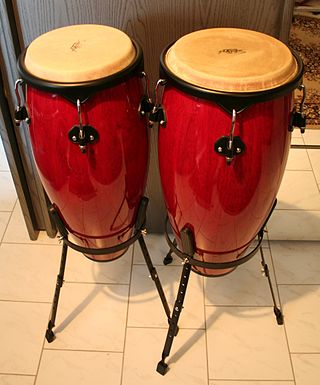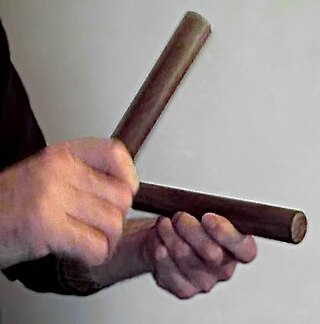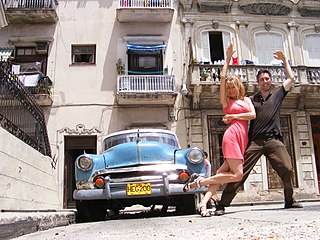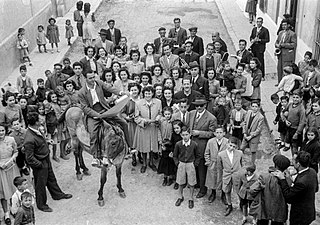
Salsa music is a style of Latin American music, combining elements of Cuban, Puerto Rican, and American influences. Because most of the basic musical components predate the labeling of salsa, there have been many controversies regarding its origin. Most songs considered as salsa are primarily based on son montuno and son cubano, with elements of guaracha, cha-cha-chá, danzón, descarga, bolero, guajira, rumba, mambo, jazz, funk, R&B, rock, bomba, and plena. All of these elements are adapted to fit the basic Son montuno template when performed within the context of salsa.
The term rumba may refer to a variety of unrelated music styles. Originally, "rumba" was used as a synonym for "party" in northern Cuba, and by the late 19th century it was used to denote the complex of secular music styles known as Cuban rumba. Since the early 20th century the term has been used in different countries to refer to distinct styles of music and dance, most of which are only tangentially related to the original Cuban rumba, if at all. The vague etymological origin of the term rumba, as well as its interchangeable use with guaracha in settings such as bufo theatre, is largely responsible for such worldwide polysemy of the term. In addition, "rumba" was the primary marketing term for Cuban music in North America, as well as West and Central Africa, during much of the 20th century, before the rise of mambo, pachanga and salsa.
The music of Cuba, including its instruments, performance, and dance, comprises a large set of unique traditions influenced mostly by west African and European music. Due to the syncretic nature of most of its genres, Cuban music is often considered one of the richest and most influential regional music in the world. For instance, the son cubano merges an adapted Spanish guitar (tres), melody, harmony, and lyrical traditions with Afro-Cuban percussion and rhythms. Almost nothing remains of the original native traditions, since the native population was exterminated in the 16th century.

The clave is a rhythmic pattern used as a tool for temporal organization in Brazilian and Cuban music. In Spanish, clave literally means key, clef, code, or keystone. It is present in a variety of genres such as Abakuá music, rumba, conga, son, mambo, salsa, songo, timba and Afro-Cuban jazz. The five-stroke clave pattern represents the structural core of many Cuban rhythms. The study of rhythmic methodology, especially in the context of Afro-Cuban music, and how it influences the mood of a piece is known as clave theory.
Latin jazz is a genre of jazz with Latin American rhythms. The two main categories are Afro-Cuban jazz, rhythmically based on Cuban popular dance music, with a rhythm section employing ostinato patterns or a clave, and Afro-Brazilian jazz, which includes samba and bossa nova.
Danzón is the official musical genre and dance of Cuba. It is also an active musical form in Mexico and Puerto Rico. Written in 2
4 time, the danzón is a slow, formal partner dance, requiring set footwork around syncopated beats, and incorporating elegant pauses while the couples stand listening to virtuoso instrumental passages, as characteristically played by a charanga or típica ensemble.
Mozambique refers to two separate styles of music.
New flamenco or flamenco fusion is a musical genre that was born in Spain, starting in the 1980s. It combines flamenco guitar virtuosity and traditional flamenco music with musical fusion.
Son cubano is a genre of music and dance that originated in the highlands of eastern Cuba during the late 19th century. It is a syncretic genre that blends elements of Spanish and African origin. Among its fundamental Hispanic components are the vocal style, lyrical metre and the primacy of the tres, derived from the Spanish guitar. On the other hand, its characteristic clave rhythm, call and response structure and percussion section are all rooted in traditions of Bantu origin.

Timba is a Cuban genre of music based on Cuban son with salsa, American Funk/R&B and the strong influence of Afro-Cuban folkloric music. Timba rhythm sections differ from their salsa counterparts, because timba emphasizes the bass drum, which is not used in salsa bands. Timba and salsa use the same tempo range and they both use the standard conga marcha. Almost all timba bands have a trap drummer. Timbas also often break the basic tenets of arranging the music in-clave. Timba is considered to be a highly aggressive type of music, with rhythm and "swing" taking precedence over melody and lyricism. Associated with timba is a radically sexual and provocative dance style known as despelote. It is a dynamic evolution of salsa, full of improvisation and Afro Cuban heritage, based on son, Rumba and mambo, taking inspiration from Latin jazz, and is highly percussive with complex sections. Timba is more flexible than salsa and includes a more diverse range of styles. Timba incorporates heavy percussion and rhythms which originally came from the barrios of Cuba.
Songo is a genre of popular Cuban music, created by the group Los Van Van in the early 1970s. Songo incorporated rhythmic elements from folkloric rumba into popular dance music, and was a significant departure from the son montuno/mambo-based structure which had dominated popular music in Cuba since the 1940s. Blas Egües was the first drummer in Los Van Van, but it was the band's second drummer, José Luis Quintana "Changuito", who developed songo into the world-wide phenomenon it is today.
Rumba flamenca, also known as flamenco rumba or simply rumba, is a palo (style) of flamenco music developed in Andalusia, Spain. It is known as one of the cantes de ida y vuelta, music which diverged in the new world, then returned to Spain in a new form. The genre originated in the 19th century in Andalusia, southern Spain, where Cuban music first reached the country.
Cuban folk music includes a variety of traditional folk music of Cuba, and has been influenced by the Spanish and the African culture as well as the remaining indigenous population of the Caribbean.

Rumba is a secular genre of Cuban music involving dance, percussion, and song. It originated in the northern regions of Cuba, mainly in urban Havana and Matanzas, during the late 19th century. It is based on African music and dance traditions, namely Abakuá and yuka, as well as the Spanish-based coros de clave. According to Argeliers León, rumba is one of the major "genre complexes" of Cuban music, and the term rumba complex is now commonly used by musicologists. This complex encompasses the three traditional forms of rumba, as well as their contemporary derivatives and other minor styles.

Pregón, a Spanish word meaning announcement or street-seller's cry, has a particular meaning in both Cuban music and Latin American music in general. It can be translated as a song based on a street-seller's cry or a street-seller's song.
The muiñeira is a traditional dance and musical genre of Galicia and some parts of Asturias (Spain). It is distinguished mainly by its expressive and lively tempo, played usually in 6
8, although some variants are performed in other time signatures. There are also variant types of muiñeira which remain in the tempo of 6
8 but which displace the accent in different ways. Muiñeira is associated with traditional choreographic schemes and the associated instrumentation is a form of bagpipe known as a gaita. It is subject to highly varied interpretation in differing local traditions. According to "Galicia-The Spanish Cousins", an article on Roots World, muiñeira is the Galician "equivalent" of a jig, which is consistent with the time signature of 6
8. The word "muiñeira" means literally both millstone and a mill landlady. Galician music is classified as part of Celtic music.
Tresillo is a rhythmic pattern used in Latin American music. It is a more basic form of the rhythmic figure known as the habanera.
The Galician League of A Coruña was a liberal and Galician regionalist political group founded in 1897 in A Coruña by the participants in the regionalist club A Cova Céltiga, with its headquarters in the Carré Aldao library; chaired by Manuel Murguía and directed by a committee consisting of Manuel Lugrís Freire, Uxío Carré Aldao and Salvador Golpe.
Coros de clave were popular choral groups that emerged at the end of the 19th century in Havana and other Cuban cities. Their style was influenced by the orfeones which grew popular in northern Spain in the mid-19th century, and their popularization in the island was linked to the emancipation of African slaves in 1886. The common instrumentation of the coros featured a viola, claves, guitar, harp and jug bass.






